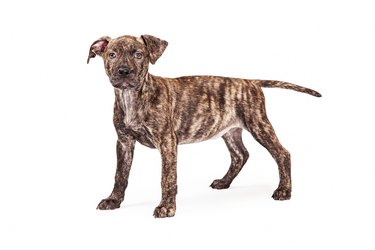
Brindle is a pattern of coloring and markings in the fur of certain types of dogs. A brindle or reverse brindle pattern is seen in boxers, French bulldogs and corgis, as well as many other types of dogs. Labradors cannot have brindle coloring, notes the Boxer World website. Reverse brindle is not considered a rare pattern but the brindling on your dog may offer you an important clue as to whether your dog is a purebred or a mix.
Brindle
Video of the Day
Boxers come in two colors: fawn and brindle. The Boxer Club of Canada's website describes fawn as occurring in "shades from light tan to stag red or mahogany, the deeper colours preferred." In boxers, brindle fur has dark striping on top of a fawn background. Any brindle color or pattern is commonly known as brindle but specific terms have come about to describe specific patterns and color combinations. Brindle may be described as "light," "golden," "fawn," "red," "mahogany," "dark," "reverse" or "seal," according to the Boxer World website.
Video of the Day
Reverse Brindle
While a regular brindle pattern occurs when dark stripes appear over a lighter-colored background, a reverse brindle pattern switches the prominence of the coloring, so light stripes appear to sit on on a dark-colored background. In actuality, the background fur is still the light or fawn color, but the dark stripes are so prominent that they give the coat the overall darker appearance. The coloring can even appear nearly solid, giving the impression that a boxer is a dark color; however, boxers that appear black, actually have a dark brindle fur and the stripes should be visible on close inspection.
Genetics
The brindle pattern in a dog's fur is determined by his genetics. The brindle gene may be expressed or hidden. Boxers can only have colorings of fawn and brindle or a lack of coloring that leads to white fur. The site also warns that there are no black boxers, as this is a genetic impossibility. The brindle pattern can affect other patterning on dogs, such as skin pigment color and nail color, according to the D'Accord Frenchies Australia website.
Brindle Expression
The Boxer World website discusses how the genes for brindle coloring are passed and expressed in these dogs. The gene that determines a brindle coat color is dominant in boxers, while the fawn gene is recessive. This means if a puppy has any brindle genes, they will show in his fur. Fawn boxers can only have fawn-colored puppies, as they must have two recessive fawn genes to display fawn coloring. Brindle boxers will have only brindle-patterned puppies if they have two brindle genes. Brindle boxers can have brindle- or fawn-colored puppies if they possess both a dominant brindle gene and a recessive fawn gene, provided they breed with a boxer that also has a dominant brindle gene and a recessive fawn gene or breed with a boxer with two fawn genes.
- Boxer World: Boxer Coat Colour
- Boxer World: Boxer Dog FAQ -- Meet the Boxer
- D'Accord Frenchies Australia; French Bulldog Coat Colour Genetics; Karen Hedberg; 2008
- The Sheltie Bloodlines Site; Brindle Genetics; March 2010
- Expert Articles; The Truth About Black Boxer Dogs; Jason Rusch; July 2008
- Aragorn Cardigan Welsh Corgi; Understanding Coat Color Inheritance...; Steve Gladstone, et al.; 1997
- Great Dog Site: Boxer Information